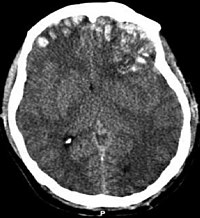
Photo from wikipedia
Traumatic brain injury (TBI) diagnoses have increased in frequency during the past decade, becoming a silent epidemic. The pathophysiology of TBI involves pathophysiological processes affecting the brain, induced by traumatic… Click to show full abstract
Traumatic brain injury (TBI) diagnoses have increased in frequency during the past decade, becoming a silent epidemic. The pathophysiology of TBI involves pathophysiological processes affecting the brain, induced by traumatic biomechanical forces resulting in temporary impairment of neurological function. Preclinical models have been generated to recapitulate the mechanical, neuroinflammatory, and behavioral outcomes observed in the clinical setting. The lateral fluid percussion (LFP) model is the most extensively used and well-characterized model of nonpenetrating and nonischemic TBI. The model is reproducible and can be adjusted to produce a mild to moderate and severe injury, as reflected by mortality and return of reflexes, by adjusting the amount of force applied. The histopathological changes achieved with this model reproduce that seen in human TBI including focal contusion in the cortex, with accompanying intraparenchymal punctate hemorrhage, followed by inflammation and neuronal degeneration. This chapter describes the LFP model, which produces a mixed model of focal and diffuse brain injury that progresses over time affecting predominantly the cortical parenchyma.
Journal Title: Methods in molecular biology
Year Published: 2018
Link to full text (if available)
Share on Social Media: Sign Up to like & get
recommendations!